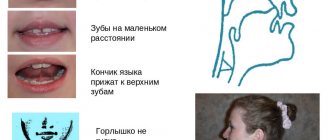Phoneme
From ancient Greek the word “phoneme” is translated as “sound”. This is the minimum unit of any language, which does not have a lexical or grammatical meaning, and is used in speech to distinguish significant units of the language.
For example, in the word HOUSE there are three phonemes <Д>, <О>, <М>. Do not confuse phonemic units with sound, they are not the same thing. You can understand why this happens with a simple example: in the word BERRY there are 5 phonemes <Я>, <Г>, <О>, <Д>, <А>, but 6 sounds [И], [А ], [G], [A], [D], [A].
One letter or sound can be expressed by different phonemes, for example, in the north G is pronounced as a plosive, and in the south - as a fricative with the oversound X, but both articulation options are presented as the phoneme <Г>.
Many teachers believe that there is no practical benefit from this knowledge for children of school and kindergarten age, but this point of view cannot be called unequivocally correct. In the first grade, children are required to distinguish between sounds and letters when performing phonetic analysis. The foundations of this skill are laid at an early age, when children hear the words mom - Masha, winter - Sima, etc. To analyze heard speech, you need to be able to differentiate, distinguish between phonemes, that is, use phonemic hearing.
On a note! Parents have been playing games to develop phonemic awareness with their children since birth, without realizing it. Conversations, songs, fairy tales, noisy toys prepare the baby for his own speech, perception of other people's statements and analysis of individual sounds and syllables.
Lessons for a five year old child
Classes with a 5-year-old child are playful in nature. At this age, children like to create objects, sculpt, design, and draw as part of play. Preschoolers love to learn, get them interested in new knowledge. Teach your child to express emotions, instill norms of behavior.
Give your child free time that he can devote to playing, do not deprive him of this opportunity. He should have 2-4 hours of free time a day. Developmental clubs are attended 1-2 times a week
Attention is paid to physical activity
Creative development
Until the age of 5, children depict graphic images. At an older age, the drawing becomes more complex, drawn, existing and imaginary objects are depicted on it. Through the drawing, the child shows his inner world. For him, the drawing process is important, the result is secondary. As part of developmental activities, an adult shows how to draw, use materials and techniques.
Through modeling and design, the child creates an idea of the world around him, of the shape and size of spatial parameters.
Classes to develop attention and memory
The main direction in working with mental processes is the development of concentration, which is a prerequisite for arbitrariness. Necessary actions:
Draw your child's attention to sounds and ask them to identify their source. Look at the clouds together and imagine. Learn to listen to your own body signals. Ask what the nose, left hand, heel feels. Use available materials for games: fruits, vegetables, natural materials. Use workbooks
In them, tasks for memory, attention, and thinking are presented in the form of exciting games. To complete them, the child draws, cuts out, uses stickers, counts, and remembers. The activities will help your child learn numbers and letters.
Studying of foreign language
At preschool age, the language system is established. The child learns to navigate the system of signs and concepts. For this purpose, his mental functions mature. Preschool childhood is a favorable period for learning a foreign language.
You should learn a new language in a playful way, without imposing classes. It is useful to include cartoons in a foreign language, audio recordings of dialogues, and show pictures with words in lessons. Language learning is combined with creative activities and physical activities (for example, playing with a ball).
Phonemic hearing
The ability to distinguish phonemes without visualizing letters and determining the sound composition of a word is called phonemic awareness. This skill underlies children's learning to read and write.
When this skill is not developed, children are delayed in speech development because they do not hear their own articulation errors:
- confuses consonants paired by deafness-voicedness, deafness-voicedness;
- makes numerous grammatical errors in speech;
- skips syllables in words;
- does not use prepositions or confuses similar pairs (over-on, in-in);
- cannot correctly express a thought, incorrectly using consonant words (luk-luk, tom-dom).
As a result, by school age the number of problems increases. Children with undeveloped phonemic awareness have the following learning problems:
- dysgraphia;
- dyslexia;
- low reading and writing speed.
- errors in searching for words with the same root, phonetic analysis, and test forms for the last consonant.
To avoid difficulties at school age, it is important to promptly notice the underdevelopment of phonemic hearing and provide speech therapy assistance to a preschooler or schoolchild. The main place in correctional work with children on the development of speech hearing is occupied by games. There are a great many of them. They can be carried out not only by speech therapists, defectologists, kindergarten teachers, but also by parents.
On a note! It is more effective to conduct games for the development of phonemic hearing in preschoolers at the age of 5-6 years. This period, according to psychologists and teachers, is the most favorable for correcting auditory perception of speech.
Games
Simple and interesting games for the development of phonemic awareness do not bother children. Use any of the listed exercise games daily. Within a month, the results of the work will be noticeable to parents and others.
On a note! To monitor the effectiveness of classes on the development of phonemic hearing in a child, after a month of training, conduct the following test with a preschooler: say some words he knows incorrectly. If your speech hearing is poorly developed, the child will not pay attention to your mistake. If he corrects your statement or makes a remark, you can give him and the teacher a “5” for quality work.
Silence
A simple didactic game for the development of phonemic awareness trains the ability to distinguish non-speech sounds. Children sit in a room or outside, close their eyes and listen to silence for 1-2 minutes. You are not allowed to talk while playing. If the lesson is carried out while walking, it is difficult to organize a complete absence of sounds, so silence means all the rustling noises, car horns, and birdsong.
When the teacher gives permission, preschoolers open their eyes and describe their impressions of the game, telling in detail what they were able to hear in silence.
Catch the sound
The game is aimed at developing phonemic hearing and attention. Can be used with children aged 6-7 years.
The child sits opposite the speech therapist and listens carefully to what sounds the teacher makes. The preschooler is given the task of clapping his hands and catching only a certain sound before the start of the game.
The teacher should slowly pronounce different sounds, and between them the correct one. If the baby claps his hands at the wrong time, that is, he caught the wrong sound, you need to point out the mistake to him. During the game, it is advisable to ask children to pronounce all the phonemes they hear out loud.
Clap-stomp
The exercise is aimed at switchability. The child stomps and claps to the sound specified by the teacher. The terms of the game must be discussed in advance. For example, a preschooler stomps to the sound [w], and claps his hands to the sound [zh].
The speech therapist pronounces a number of similar sounds: [w], [sch], [ch], [zh], [s], [zh], [x], [sh], etc. A preschooler should not react to unmarked sounds with body movements.
Catch the syllable
A game for the development of phonemic hearing and attention switching in children 5-6 years old. It is carried out identically to the previous one, but the child catches not sounds, but syllables. The conditions are discussed as follows: catch the syllable CHU. The teacher pronounces a series of syllables, trying to confuse the student: CHA, SHU, CHU, SCHU and so on. The child should only catch the syllable CHU.
Catch the word
The exercise forms a high level of attention, develops the ability to distinguish syllables and sounds in isolation, surrounded by other phonemes.
The teacher tells the child what word to catch, for example, pike. Pronounces a number of similar-sounding words and the following: joke, pike, fur coat, teeth, pike, and so on. When the preschooler hears the right word, he claps his hands.
Echo
This game for the development of phonemic hearing can be played with several children aged in the middle group of preschool educational institutions. First, tell the students what an echo is and how it “works.” Practice together, repeating words, sounds, syllables one after another. Then determine which of the children will be an echo and which will be a traveler in the mountains.
When the roles are assigned, leave the children to play on their own, without your prompts. The traveler speaks simple words, syllables, and the “echo” repeats what he heard exactly, possibly several times.
Catch the song
The game is suitable for children with underdeveloped attention, with poor ability to hear sounds as part of a syllable or word. The teacher sets a sound that is problematic for the student, most often these are whistling, hissing, and sonorous sounds.
Let's take, for example, phoneme B. The teacher must name a number of words with and without a given sound: bank, fur coat, pacifier, folder, drum, pulka, bulka and so on. The child’s task: clap your hands if you hear the desired sound.
Loud quiet
The lesson is conducted with musical accompaniment. Children stand in a circle and begin to move in steps to the composition. When the music is loud, you need to stand on your toes; if the sound becomes quiet, you need to sit down and goose-step.
On a note! It is recommended to change differentiated movements and musical composition at each lesson.
High-low
The exercise is identical to the previous one. When low tones are heard, such as a drum or trombone, children crouch. When there are loud sounds, they move on tiptoes.
Tell me how I am
The game task is aimed at developing the ability to distinguish between loud and quiet sounds; children learn to adapt to the timbre of the interlocutor’s voice. The teacher pronounces words and small phrases at different volumes, the children listen and repeat.
On a note! For the exercise “Say it like me!” Choose words and sounds that children have the greatest difficulty pronouncing.
Lay it out correctly
Prepare cards with paired and unpaired sounds: Z-S, Zh-Sh, Ch-C, Shch, V-F, X, R, B-P. And in addition to this card index, print out an image of objects whose names contain these phonemes. The child must match them. For example, attach a card with the letter Z to the image of an umbrella, and S to the elephant. The result will be several piles of cards.
After 2-3 lessons with cards, invite the children to arrange the pictures according to other principles:
- find names of objects with the desired sound at the end, beginning, middle of a word;
- classify words by number of syllables;
- come up with words starting with a given letter yourself, for example, verbally spell out the names of all the objects that are in the room.
Sound lotto
The game is played in a group (at least 2 people and a leader). Suitable for children already familiar with letters, or can be combined with ABC activities. To play you need to prepare:
- Lotto with pictures (animals, birds, objects).
- Blank cards.
Do some prep work first. Find out which letters are familiar to preschoolers, explain that consonant sounds can be soft-hard, deaf-voiced, show how to pronounce them correctly. Then give the children 4-6 pictures and the same number of blank cards.
Name any sound, stretching and singing it: z-z-z. Ask who has this sound in the names of their drawn objects. Children raise their hands and repeat: “I have a z-z-zebra!” And cover the correct picture with a blank card. The winner is the one who fills the field faster.
Important! Watch how children pronounce words and individual sounds. Combine the game with articulation training and pronunciation correction.
Syllabic train
A task to develop the ability to divide words into syllables. Prepare cards with drawn carriages, each with 1 syllable written on it. The children's task is to arrange the syllables in the carriages. For preschoolers 5-6 years old, take words with 2-3 syllables, for schoolchildren 6-7 years old - with 3-4 syllables.
Confusion
Children with a phonemic hearing defect confuse sounds in their speech; the confusion game will help cope with this deficiency. First, tell the children about what can happen if you put the wrong letter in a word, how its meaning and the meaning of the statement as a whole will change.
Give simple, and preferably funny, examples of funny situations. For example, Mishka loves to eat cheese. I must say mouse, but bears don’t eat cheese. Then invite the children to correct the mistakes in words and sentences so that the meaning of the statement is correct:
We came to ride on the big Cork. There are a lot of slippery Lobes in the swamp. Ivan built a new Tom.
If possible, accompany lessons with confusing words with pictures and plot illustrations.
Broken phone
You need to play in a group, gather groups of 5-8 children. The first participant thinks of a word, first of 2-3 syllables, and mumbles it into his neighbor’s ear. The next person tries to understand what he heard and passes the word to the person sitting next to him. And so on down the chain. The last child says what he understands out loud. Children compare the initial and final results, analyzing what has changed in it.
Speech therapy tasks
Starting with the letter R
One of the most difficult sounds to master is R. Many preschoolers learn to roar loudly by the very end of kindergarten. If the production of the sound P is already behind you, then special exercises will help speed up its automation:
1. “Like a little motor”
We ask the child to pronounce the sound R in the word for a long time, drawlingly (like a motor growls).
2. “Where is R hiding?” (in pictures and words)
Offer to choose pictures with images of objects with a given sound or clap your hands if he hears such a word.
3. “How can you growl?”
Show your child pictures of objects that have the sound r in their names. Offer to read and color the picture.
4. “Sounding tracks”
Together with your child, come up with several chants made up of several syllables:
Ra-ra-ra - they ran away from the yard.
Ro-ro-ro - and they found a bucket.
Ru-ru-ru - we came up with a game.
5. “Substitute a syllable”
The adult offers the child words that end or begin with a syllable with P (ra, ro, ry), the child must choose the correct option and pronounce it correctly.
6. “Look and name”
An adult asks the child to read words with the letter r from the pictures. The word must be said as many times as there are stars next to each picture.
7. “Poems, tongue twisters, riddles”
Learn with your child several poems and riddles in which words with R appear.
Starting with the letter L
The hard sound L is also often difficult for children 5-6 years old. If the baby has already learned to pronounce it alone, in isolation, then it’s time to start working on automation in speech. The following exercises are suitable for this:
1. “Say it nicely”
Offer your child several images of words starting with L. Ask him to pronounce the words beautifully, emphasizing the desired sound with his voice.
2. “Toys for Larisa”
Ask your child to collect gifts for the Larisa doll. Tell her that she only likes things that begin with L. For this exercise, you need to select small objects or pictures in advance; all words should not begin only with L.
3. “One-many”
Invite your child to name words with L in the singular and plural. In the workbook for the sound L (author Kostyuk A.V.) there is a whole table with pictures for this exercise (lesson 20).
4. “Find the Sound”
Invite your child to draw up a diagram of the word and mark the place L on it. If it is still difficult for your child to independently determine the number of sounds, then first you can do several similar exercises from the workbook.
5. “Tongue twisters and nursery rhymes”
Use nursery rhymes, tongue twisters and poems with words that contain L.
Starting with the letter Sh
Difficulties with hissing in children 5-6 years old are also quite common. The following games are suitable for automation:
1. “Who’s hissing?”
Invite your child to choose several pictures of those who can hiss. Ask them to say their “song” clearly, loudly, and for a long time.
2. “Catch the Sound”
Ask your child to clap their hands every time you say Sh or a word with that sound (among others).
3. “Syllables Travel”
Take a card with one of the syllables SHA, SHO, SHU. Offer to come up with words or several that begin with this syllable and end with it (Sha-ry and ka-Sha, sho-rokh and ho-ro-sho).
4. “What are the guys’ names?”
Ask your child to read the children's names, adding the syllable SHA at the end.
4. “We compose speech therapy rhymes”
Come up with short rhythmic chants with the syllables SHA, SHO, SHU, SHI.
Sha-sha-sha - the porridge ran away,
Sho-sho-sho - have a good rest,
Shu-shu-shu - dry mushrooms and berries.
5. “Speak beautifully and correctly”
Ask your child to pronounce words with the Sh sound correctly.
The use of workbooks not only allows you to properly organize speech development classes for children 5-6 years old, but also makes it possible to train graphic skills, attention, thinking, and imagination. To reinforce the material, also use video lessons:
To reinforce the material, also use video lessons:










